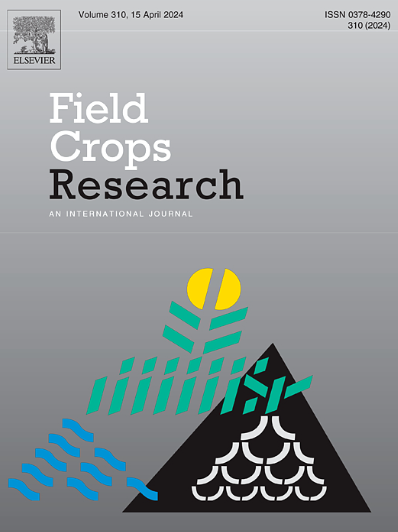在坦桑尼亚,玉米间作增加了粮食产量和土壤覆盖,并减少了虫害的压力
IF 5.6
1区 农林科学
Q1 AGRONOMY
引用次数: 0
摘要
背景:东非农民和研究人员对Lablab purpureus (L.)重新产生了兴趣。甜,一种多用途豆科覆盖作物。Lablab可以生产食物和饲料,固定氮,清除资源,保护土壤,耐旱。为了充分利用其潜力,lablab需要对其基本农艺进行更多的研究,特别是在东非小农通常种植的间作情况下。目的通过3个生态系统服务指标的测量,了解实验室与玉米间作的影响:1)实验室与玉米的粮食产量,以产量和土地当量比评估;2)活植物材料晚季土壤覆盖度;3)实验室主要害虫:食荚毛虫(Maruca vitrata, Helicoverpa armigera, Etiella zinckenella)和食荚虫(Riptortus pestris, Clavigralla tomentosicollis)。方法在坦桑尼亚北部的两个农业生态区,用玉米间作lablab 3年。产量数据收集了两种作物,而后期土壤覆盖和昆虫压力集中在实验室。一项简单的经济分析考察了单作和间作的净收益对种子和收获成本的反应。结果在6种环境下,间作使实验室粮食减产35% % (p = 0.009);间作略微降低了玉米产量,但不显著(p = 0.087)。不同环境下玉米与实验室的土地等效比在1.36 ~ 1.96之间。在水分充足的条件下,种植玉米的lablab比单独种植lablab的晚季地面覆被多58 % (p = 0.039),而在最干燥的环境中,观察到相反的趋势(p = 0.011)。间作可使螟虫(p = 0.052)和吸虫(p <; 0.001)的数量分别减少34 %和57 %。间作的净收益高于单作或玉米。这些结果表明,在实验室种植玉米具有多种好处,可以提高粮食产量,增加土壤保护,减少虫害压力。特别重要的是,与玉米一起种植的实验室对玉米谷物产量的影响可以忽略不计,这突出表明,在小农农业中,间作的不利影响被其优势所抵消。继续进行实验室研究,以确定最佳农艺做法和新品种,这将鼓励采用这种做法,并帮助东非农民多样化和加强他们的种植制度。本文章由计算机程序翻译,如有差异,请以英文原文为准。
Intercropping lablab with maize increases grain production and soil cover, and reduces pest pressure in Tanzania
Background
East African farmers and researchers are sharing a renewed interest in Lablab purpureus (L.) Sweet, a multipurpose leguminous cover crop. Lablab can produce food and fodder, fix nitrogen, scavenge resources, protect the soil, and tolerate drought. To capitalize on its potential, lablab requires more research into its basic agronomy, particularly under intercropping situations in which it is usually grown by small-holder farmers in East Africa.
Objectives
The study aimed to understand the effects of lablab-maize intercropping through three measured ecosystem services: 1) grain production of lablab and maize, assessed in yield and land equivalent ratio; 2) late season soil cover of living plant material; and 3) major lablab insect pests: pod boring caterpillars (Maruca vitrata, Helicoverpa armigera, Etiella zinckenella) and pod sucking coreid bugs (Riptortus pedestris, Clavigralla tomentosicollis).
Methods
In this study, lablab was intercropped with maize across two agro-ecozones in northern Tanzania over three years. Yield data was collected from both crop species, while late season soil cover and insect pressure focused on lablab. A simple economic analysis examined net return of sole and intercropping as a response to the costs of seed and harvesting.
Results
Over the six environments, intercropping reduced lablab grain yields by 35 % (p = 0.009); intercropping reduced maize yields marginally though this was not found to be significant (p = 0.087). The land equivalent ratio of maize and lablab, ranged from 1.36 to 1.96 across environments. Under adequate moisture conditions lablab grown with maize produced 58 % more late season ground cover than when lablab was sole cropped (p = 0.039), whereas in the driest environments, the opposite trend was observed (p = 0.011). The number of pod boring caterpillars (p = 0.052) and pod sucking coreid bugs (p < 0.001) were reduced by 34 % and 57 % respectively by intercropping. Intercropping produced a higher net return than sole cropping lablab or maize.
Conclusions
These results demonstrate the diverse benefits of growing maize with lablab allowing for greater food production, increased soil protection, and reduced pest pressure. Of particular importance was the negligible effect of lablab grown with maize, on maize grain yield, highlighting that the detractions of intercropping in smallholder agriculture are outweighed by the advantages. Continued lablab research to identify best agronomic practices and new cultivars will encourage its adoption and help East African farmers diversify and strengthen their cropping systems.
求助全文
通过发布文献求助,成功后即可免费获取论文全文。
去求助
来源期刊

Field Crops Research
农林科学-农艺学
CiteScore
9.60
自引率
12.10%
发文量
307
审稿时长
46 days
期刊介绍:
Field Crops Research is an international journal publishing scientific articles on:
√ experimental and modelling research at field, farm and landscape levels
on temperate and tropical crops and cropping systems,
with a focus on crop ecology and physiology, agronomy, and plant genetics and breeding.
 求助内容:
求助内容: 应助结果提醒方式:
应助结果提醒方式:


